LB parks/wildlife advocate and El Dorado Park watchful citizen Ann Cantrell tipped us to the fish-kill.
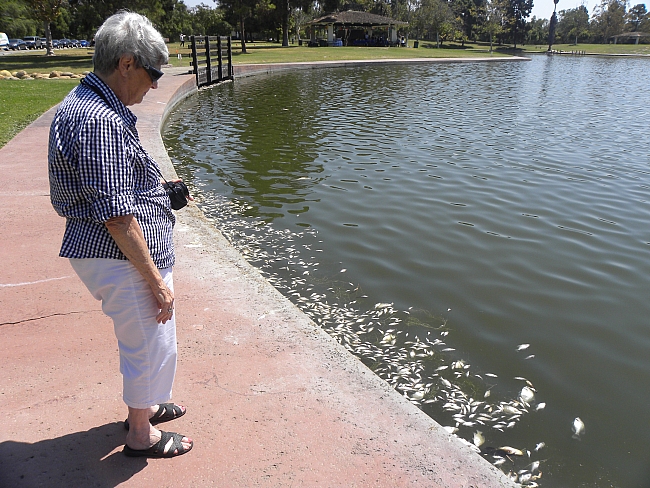
We snapped the photos seen on this page in the noon hour on Sept. 6 and asked LB Dept. of Parks, Recreation and Marine what they know.
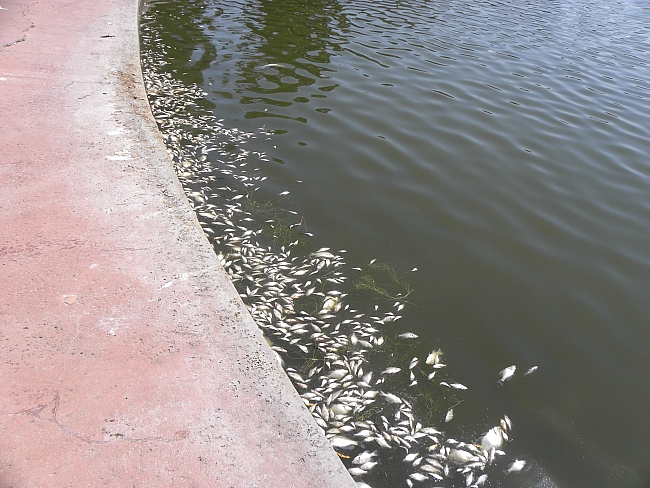
Area II lake, north shore, Sept. 6, 2017
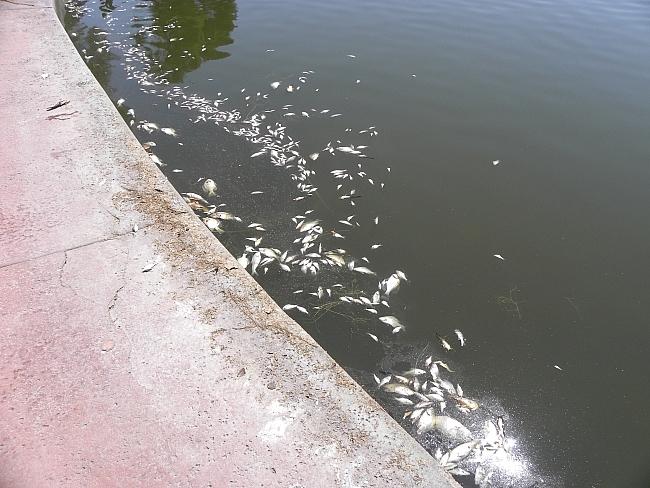
Area II lake, north shore, Sept. 6, 2017
By late afternoon, Anabell Chavez in the City of Long Beach's Public Affairs Office (part of the City Manager's office) provided us with the statement below:
The likely cause of these dead fingerling fish could be due to lack of oxygen directly related to the hot weather conditions. Treatment of the algae bloom at some lakes has also started as of yesterday, September 5, which might have had some impacts to the fingerling fish, but it is still not confirmed as waters are being tested. Treatments to the algae bloom should have benign impacts to anything else aside from the algae.Signs will be posted in the affected areas with appropriate warnings and cautions related to the treatment of the algae blooms. The City is working closely with the Health Department and State Waterboard to develop a monitoring and management plan for the lakes,
[As our photos above show, some of the dead fish (not many but a few) were beyond fingerling size.]
Sponsor | Sponsor |
By way of context, on April 20, 2017, the Los Angeles Regional Water Quality Control Board issued a release noting that harmful Cyanobacteria blue or green algae blooms had been found in some El Dorado Park ponds and urged caution to prevent contact by pets and children.
[April 20 LARWQCB release text] -- State and local environmental and public health agencies have joined together to warn Long Beach residents and recreational users visiting El Dorado East Regional Park to exercise caution after environmental testing has confirmed the presence of cyanobacteria harmful algal blooms (cyanoHABs), also known as harmful or blue green algae blooms, in waterbodies at the park. This is the first confirmed cyanoHAB reported for the region this season (2017)....Field and lab results show that the surface water contains high concentration of cyanobacteria. Lab testing confirmed presence of cyanobacteria species capable of producing many cyanobacteria toxins and low levels of the toxin Anatoxin-a was detected. The levels of Anatoxin-a, a neurotoxin, exceeded the caution trigger level (found here) -- recommending caution signs to be posted near recreational areas and any area that provides access to the water.
The concentration of the toxin is low and does not pose a threat to people swimming in the water. However, ingestion of algal material (such as scums and mats) could be dangerous. .
Children should be kept away from algal material in the water and on the shore. Do not let children play or wade in areas that have any algal material and do not let them put any algal material in their mouths.
The most high-risk groups are dogs and wildlife as they eat the algal material and drink the water. Dog, fish and wildlife deaths have occurred in California every year from algal blooms, so keep your pets out of the water and away from algal material accumulated on the shore. Ifthey do swim in the water, they should be rinsed off with fresh water to remove any algal material from their fur...
Signs warning about the presence of harmful cyanobacteria have been posted by the City of Long Beach's Department of Parks, Recreation and Marine.
Cyanobacteria toxins can be present even though a bloom is not visible. HABs vary in color and may range from vibrant to dark green, blue-green, yellow, brown, black, or red. It is also worth noting that not all CyanoHABs will appear as accumulations on the surface of water as some are benthic (i.e. attached to the bottom of the waterbody), and others are planktonic (i.e. float within the water column at various depths). Bloom conditions can change rapidly and wind and waves may move or concentrate the bloom into different regions of these water bodies.
Not all areas of the water bodies have been tested for harmful cyanobacteria. As reports come in of algal blooms, State Water Board staff may follow up with appropriate environmental tests. Recreational exposure to cyanobacteria and associated toxins can cause eye irritation, skin rash, mouth ulcers, vomiting, diarrhea and cold and flu-like symptoms. Pets can be especially susceptible because they tend to drink while in the water and lick their fur after, increasing their risk of exposure and illness. Symptoms of animal illness include: vomiting and/or diarrhea, lethargy, abnormal liver function test results, difficulty breathing, foaming at the mouth, muscle twitching and death...
People are still encouraged to come to El Dorado East Regional Park and enjoy activities at the park. However, we recommend that water users exercise healthy habits when playing in waters that have identified cyanobacteria blooms.
The Statewide Guidance on Cyanobacteria and Harmful Algal Blooms recommends the following for waters impacted by cyanobacteria:
- Keep pets and other animals out of the water. Do not allow them to drink the water or eat algal material (scum) on shore. If they do get in the water, do not let them drink the water, swim through algal material, scums or mats, or lick their fur after going in the water. Rinse pets in clean water to remove algal material and potential toxins from fur.
- Avoid areas of accumulated algae, scums or mats when wading or swimming, or recreational boating.
- Do not drink untreated surface water from these areas or use it for cooking.
- Limit or avoid eating fish from these areas; if fish are consumed, throw away guts and liver, and clean filets with tap water or bottled water before cooking.
- Get medical treatment immediately if you or your pet gets sick after going in the water. Be sure to alert the medical professional to the possible exposure with cyanobacteria. Also, make sure to contact the local county public health department.
Sponsor |  |
We didn't see any blue or green algae on the surface of the north shore of Area II lake (south of Wardlow Rd.)...but we didn't travel the full circumferance of the lake.
However we did see some algae and photographed it (below) on the surface of the west side of the Area III lake (north of Wardlow Rd.) where we saw fingerling fish alive and swimming a few feet from it (photos below).
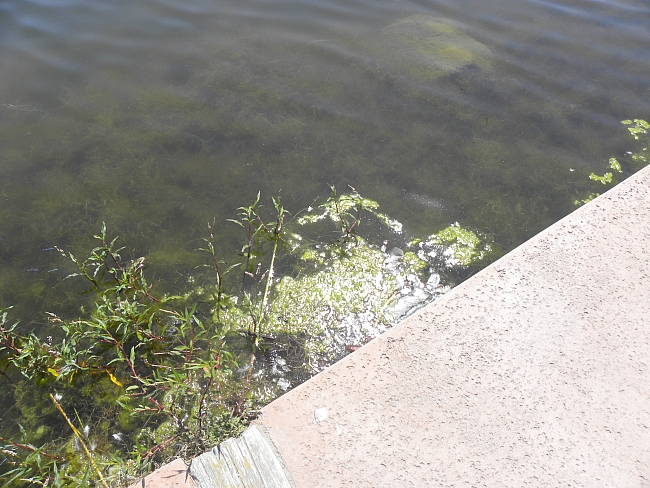
Area III, western shore, Sept. 6, 2017
Sponsor | Sponsor |
We also saw warning signs near the Area III lake (photo below.)
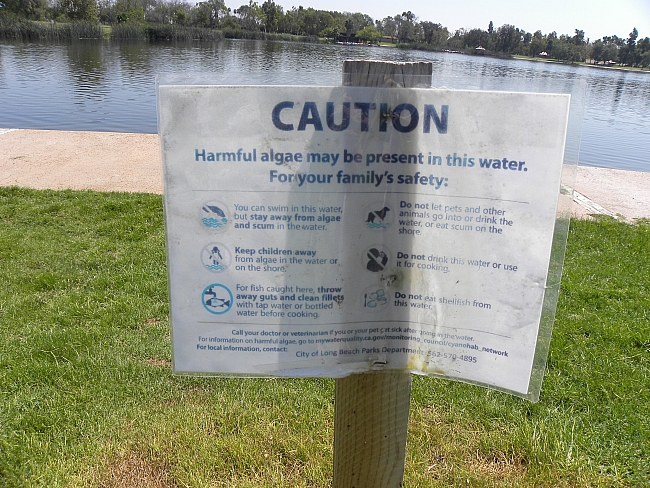
Area III, western shore, Sept. 6, 2017
Sponsor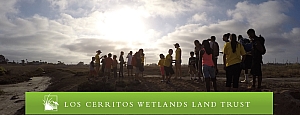 |
At this point, it's a mystery whether the dead fish in the Area II lake were killed by toxic algae, or something added to the water that was supposed to kill the algae and not affect park critters, or by something else.
Further as we learn it.
blog comments powered by Disqus
Recommend LBREPORT.com to your Facebook friends:
Follow LBReport.com with:
RSS |
Contact us: mail@LBReport.com





Hardwood Floor Specialists
Call (562) 422-2800 or (714) 836-7050
